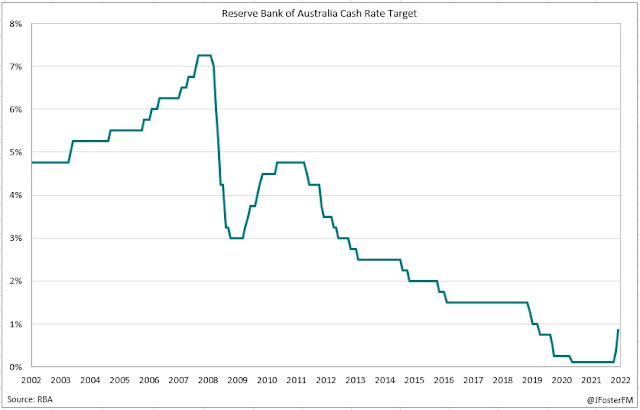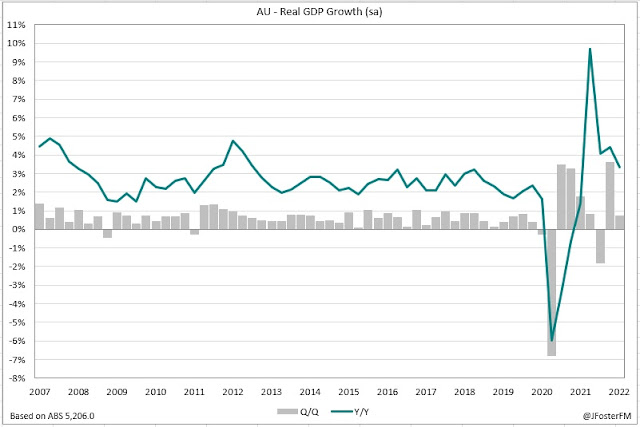A challenging outlook for growth prospects is leading to increasingly complex reactions in markets. We see bond yields having pulled back over the week on the risks of recession, an outlook that has weighed on the commodities complex and contributed to falling inflation expectations. Equities have rallied, potentially driven by the idea that weaker growth and inflation declining will allow central banks to pivot from their messaging around the need to keep hiking rates quickly.
Global growth is slowing going into Q3
The round-up of global PMIs reflected the slowing growth thematic that was prevalent in markets this week. Although still remaining above the 50 level and consistent with economic activity expanding, June's advanced PMI readings suggested that the pace of growth had slowed across the US, Europe and the UK after opening up the second quarter with strong momentum. Some of the common themes were that demand had softened in response to high inflation and weak confidence, while manufacturing output had continued to slide due to the renewed supply disruptions caused by the Ukraine war and China's lockdowns.
The slowdown had been most pronounced in Europe, with the composite PMI easing to a 16-month low at 51.9 from May's 54.8 reading. The close proximity to the Ukraine war was adversely affecting business and consumer confidence, and the services sector that had seen a boost following the easing of Covid restrictions for the summer was losing momentum. The UK's PMI reading had held up at 53.1 in June, unchanged from May, though weakness in new order growth and declining confidence pointed to slowing activity ahead. In the US, June's PMI reading at 51.2 was its weakest since the start of the year as spending in the services sector, particularly in discretionary-related areas, had weakened with household incomes squeezed by high inflation. Price pressures were still elevated, though they appeared to be easing as demand was cooling.
RBA monitoring inflation expectations
With Australian inflation unlikely to peak until later in the year, RBA Governor Philip Lowe in a speech this week reaffirmed the guidance that further rate hikes remain on the table. Ongoing pressure on fuel and energy prices has prompted the RBA to lift its forecast for peak inflation from around 6% to 7% in the fourth quarter. While monetary policy cannot address these impulses pushing up inflation, Governor Lowe has also been highlighting the influence on inflation from strong demand in the Australian economy running up against capacity constraints. The most important insight from the speech was that higher rates were needed not only to bring demand into closer alignment with supply but also to keep inflation expectations anchored in the 2-3% target range.
The June meeting minutes revealed that the Board's decision to speed up to a 50bps hike from a 25bps hike at the previous meeting was taken due to a shifting "inflation mindset" in which firms are increasingly willing to pass through higher input costs into prices, while workers, in the knowledge the labour market is strong, could be on the press for higher wages to compensate for the rising cost of living. While a 50bps hike is already expected in July, I think this week's communications indicate a 50bps hike in August could be a real possibility as well. Given the August meeting will come on the back of the Q2 inflation data, the risk is a strong print could prompt another upward revision to the RBA's inflation forecasts that will accompany that meeting, thereby making it difficult for the Board to scale back to a 25bps hike at that juncture. If the Board was to end up hiking by 50bps in August (for a total of 175bps since May), I'd expect a pause would then be likely, with rate hikes not coming back onto the radar until November following the Q3 CPI data and revised RBA forecasts.
Fed committed to the inflation fight
Over two days of testimony to the Congress, Fed Chair Jerome Powell told lawmakers the FOMC's commitment to lowering inflation was "unconditional". Chair Powell reiterated that this commitment would see the FOMC continuing to hike rates "expeditiously", removing stimulatory policy that was adding to inflation pressures. Pressed on whether an aggressive tightening cycle could cause the US economy to slow sharply and potentially tip into a recession, Chair Powell conceded that while it was a possibility, a downturn was not a necessary antidote to high inflation. But, overall, the tone was consistent with the messaging coming out of last week's policy meeting that the FOMC has shifted to prioritising inflation over risks to growth.
UK inflation continues to rise
Headline inflation is yet to peak in the UK, with 12-month CPI ticking up to 9.1% in May from 9% in April. The BoE expects the peak will come later this year in Q4, with the pace running in double digits by that stage factoring in the next increase in the household energy price cap. After accelerating to 6.2% in April, the core rate eased by more than expected to print at 5.9% in May. The inflation situation keeps the option of a 50bps rate hike from the BoE in play, and the MPC's Catherine Mann, one of the three members who voted for that course of action at last week's meeting, said in a speech her view was partly shaped due to the depreciation in the Sterling that was boosting imported inflation. However, a weak result for retail sales in May (-0.5%m/m) and a fall in consumer sentiment to a record low are indicative of the strains households are feeling and could point to the BoE remaining with 25bps rate hikes.




































